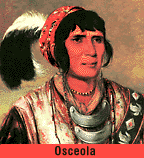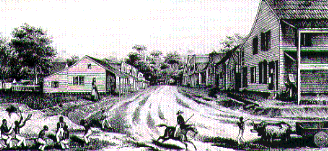Territorial Period
 Andrew Jackson returned to Florida in 1821 to establish a new territorial government on behalf of the United States. What the U.S. inherited was a wilderness sparsely dotted with settlements of native Indian people, African Americans, and Spaniards.
Andrew Jackson returned to Florida in 1821 to establish a new territorial government on behalf of the United States. What the U.S. inherited was a wilderness sparsely dotted with settlements of native Indian people, African Americans, and Spaniards.
As a territory of the United States, Florida was particularly attractive to people from the older Southern plantation areas of Virginia, the Carolinas, and Georgia, who arrived in considerable numbers. After territorial status was granted, the two Floridas were merged into one entity with a new capital city in Tallahassee. Established in 1824, Tallahassee was chosen because it was halfway between the existing governmental centers of St. Augustine and Pensacola.
As Florida's population increased through immigration, so did pressure on the federal government to remove the Indian people from their lands. The Indian population was made up of several groups–primarily, the Creek and the Miccosukee people; and many African American refugees lived with the Indians. Indian removal was popular with white settlers because the native people occupied lands that white people wanted and because their communities often provided a sanctuary for runaway slaves from northern states.
 Among Florida's native population, the name of Osceola has remained familiar after more than a century and a half. Osceola was a Seminole war leader who refused to leave his homeland in Florida. Seminoles, already noted for their fighting abilities, won the respect of U.S. soldiers for their bravery, fortitude, and ability to adapt to changing circumstances during the Second Seminole War (1835–42). This war, the most significant of the three conflicts between Indian people and U.S. troops in Florida, began over the question of whether Seminoles should be moved westward across the Mississippi River into what is now Oklahoma.
Among Florida's native population, the name of Osceola has remained familiar after more than a century and a half. Osceola was a Seminole war leader who refused to leave his homeland in Florida. Seminoles, already noted for their fighting abilities, won the respect of U.S. soldiers for their bravery, fortitude, and ability to adapt to changing circumstances during the Second Seminole War (1835–42). This war, the most significant of the three conflicts between Indian people and U.S. troops in Florida, began over the question of whether Seminoles should be moved westward across the Mississippi River into what is now Oklahoma.
Under President Andrew Jackson, the U.S. government spent $20 million and the lives of many U.S. soldiers, Indian people, and U.S. citizens to force the removal of the Seminoles. In the end, the outcome was not as the federal government had planned. Some Indians migrated "voluntarily." Some were captured and sent west under military guard; and others escaped into the Everglades, where they made a life for themselves away from contact with whites.
Today, reservations occupied by Florida's Indian people exist at Immokalee, Hollywood, Brighton (near the city of Okeechobee), and along the Big Cypress Swamp. In addition to the Seminole people, Florida also has a separate Miccosukee tribe.
By 1840 white Floridians were concentrating on developing the territory and gaining statehood. The population had reached 54,477 people, with African American slaves making up almost one-half of the population. Steamboat navigation was well established on the Apalachicola and St. Johns Rivers, and railroads were planned.
 Florida now was divided informally into three areas: East Florida, from the Atlantic Ocean to the Suwannee River; Middle Florida, between the Suwannee and the Apalachicola Rivers; and West Florida, from the Apalachicola to the Perdido River. The southern area of the territory (south of present-day Gainesville) was sparsely settled by whites. The territory's economy was based on agriculture. Plantations were concentrated in Middle Florida, and their owners established the political tone for all of Florida until after the Civil War.
Florida now was divided informally into three areas: East Florida, from the Atlantic Ocean to the Suwannee River; Middle Florida, between the Suwannee and the Apalachicola Rivers; and West Florida, from the Apalachicola to the Perdido River. The southern area of the territory (south of present-day Gainesville) was sparsely settled by whites. The territory's economy was based on agriculture. Plantations were concentrated in Middle Florida, and their owners established the political tone for all of Florida until after the Civil War.
